We have been busy practising for our outdoor nativity performances next week – we hope that the weather is kind and that you can join us!
If you would like to help your child practise at home, here is a copy of the words to our songs.
We have been busy practising for our outdoor nativity performances next week – we hope that the weather is kind and that you can join us!
If you would like to help your child practise at home, here is a copy of the words to our songs.
We are always in need of resources for our junk modelling area and would be grateful for any donations of:
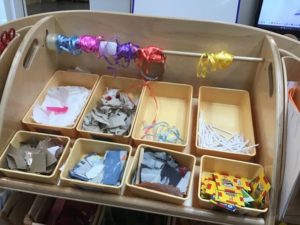 Many thanks for your donations.
Many thanks for your donations.
Junk modelling or recycled art is being creative with materials that would otherwise be discarded. Junk modelling construction gives children the freedom to build what they want with the addition of resources like tape and glue.
Modelling with recycled resources encourages higher order thinking. Children can work on their own or co-operate with others, learning to explore and share ideas. When they create something new it can build self confidence and boost self-esteem. Junk modelling is all about the learning process rather than the end product.
Here are some examples of what we have made so far this term:
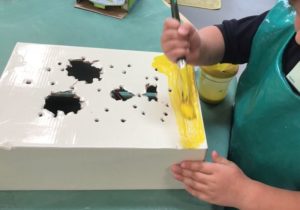
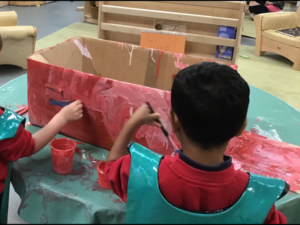
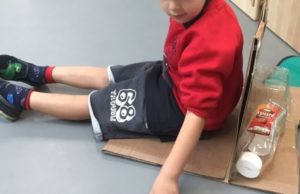
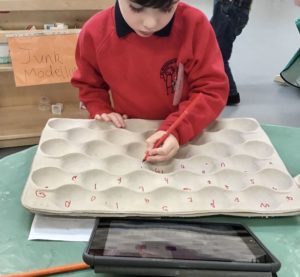
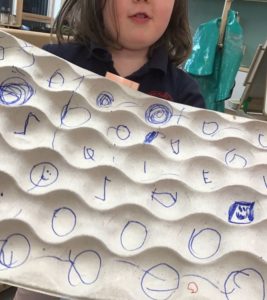
Up-cycling!
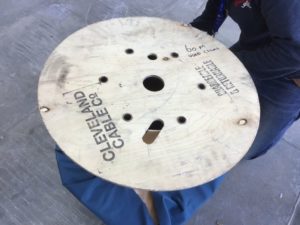 Donated cable drums have also been up-cycled to make tables for our indoor role play areas and outdoor areas. We measured offcuts of cloth, cut them to size and stapled them to the cable drum surface.
Donated cable drums have also been up-cycled to make tables for our indoor role play areas and outdoor areas. We measured offcuts of cloth, cut them to size and stapled them to the cable drum surface.
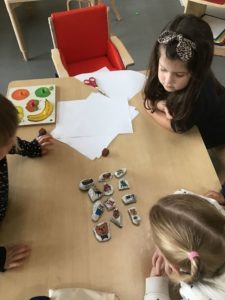 Story stones are great resources for developing children’s communication skills, promoting their language skills and encouraging their imagination and creativity.
Story stones are great resources for developing children’s communication skills, promoting their language skills and encouraging their imagination and creativity.
Here are some ideas you can use story stones for at home..
When using the story stones use language such as:
These phrases help develop your child’s ability to predict and retell stories they are both familiar and unfamiliar with.
All you need to make your own story stones are:
If you try this at home, why not share your photographs with us on Twitter @GlenwoodFC
In all our rooms we love exploring our favourite books. We use puppets and props to help us retell traditional tales.
“The troll is scary! He tries to eat the goats. I like the bit when the goat hits him with its horns.”
Taking part in regular Bookbug sessions, we have enjoyed listening to familiar stories and we have been learning some new songs, as well as reciting our favourite nursery rhymes.
Look out for links to our Google meet Bookbug sessions next week for Math Week Scotland and you can join in from home too!
 We are excited to be beginning our Woodland Adventures in Eastwood Park again soon!
We are excited to be beginning our Woodland Adventures in Eastwood Park again soon!
We have made changes to how we will be running these this session to better accommodate the varying patterns of attendance of our children. Each room will have a block of four weeks, with sessions on Tuesday, Wednesday and Thursday mornings, and also a Wednesday afternoon.
Our first visits this session will begin during the week beginning 13th September:
Our Woodland Adventures Handbook will tell you all about them:
 All children will need a completed permission form to participate, including children who were at Glenwood before the summer. Please return forms as soon as possible to enable your child to access Woodland Adventures fully.
All children will need a completed permission form to participate, including children who were at Glenwood before the summer. Please return forms as soon as possible to enable your child to access Woodland Adventures fully.
Information on additional safety measures that have been put in place due to the current Covid19 situation can be found here:
If you have any further questions, please don’t hesitate to get in touch and we will be happy to answer them.
The children participated and enjoyed our Sports Day on the 25th May. Kerry Comerford, our Active Sports Coordinator, set up a number of activities and sports for us to try – inluding bowling, curling and gymnastics. The children were running, hurling, balancing and jumping. After the activities the children enjoyed ice lollies.
The children have been very interested to learn about planting and growing runner bean seeds for our new family centre. By placing a runner bean seed in a zip lock bag with some wet cotton wool and sticking this on to the window, the children were able to observe the seeds germinate as the roots and shoots started to grow.
“I can see the roots going down and the shoots going up.”
“They are going to be so tall.”
“The roots are getting really long now.”
After about 10 days the children filled some small plant pots with soil and carefully planted a seedling in each one and then watered them all.

“I will give them some water. They need water so they can grow.”
The children took responsibility for checking that the soil in the pots was not too dry and made sure each plant had enough water to help it grow.
“The beans need a little drink of water. I touched the soil with my finger and it felt dry.”
To prepare for planting the runner beans outdoors a handheld drill was used to drill drainage holes in planters, the planters were filled with soil and canes were added to provide support.
“I’m turning the handle round and round. I can see little bits of plastic at the bottom.”
To help carefully remove the plant from the pot without damaging it, the children learned about gently rolling and squeezing the pot with their fingers and hands. They were very interested to see how the roots had grown inside the pot.
“Look at all the roots. There are so many.”
When the children had finished planting all the runner bean plants they chose a sunny spot to put them in the garden and gave them a big drink of water.
“The beans are really tall. They have lots of leaves.”
Further information about growing runner beans can be found on the following website: https://www.gardenersworld.com/how-to/grow-plants/how-to-grow-runner-beans/
The children in the Orchard Bubble have been having a great time in the nursery with our obstacle course equipment. We have been learning to work together as a team and use everyone’s ideas to create the courses. We have also been learning about how to risk assess for ourselves.
The children decided to add to the obstacle course and make one where they have to use their gross motor skills to hop and jump.


Then the children wanted to use the big blocks inside to create a big obstacle course together.



When we create and use obstacle courses we are not just developing our gross motor skills but also learning to share, take turns and cooperate with each other.
Many of the children have been enjoying playing with the new dinosaurs. We had lots of questions so we watched some videos on Tig Tag Junior. We learned about how they became extinct.
“When a big space rock made some dust it made the place go dark. Then without sunlight the plants died. Then without plants the plant-eating dinosaurs died. Then all the meat-eaters died. Then they all started to die. Extinct.”
“What size was a T-Rex?”
We used books to research and discovered that a Tyrannosaurus rex was 12 metres long. Would it fit in our playroom? Let’s find out by measuring…

Our playroom is 10 metres long – “T-rex’s head would be next door!”  Which dinosaur is smallest? We researched on the iPad. Compsognathus was 60cm long and 40cm tall.
Which dinosaur is smallest? We researched on the iPad. Compsognathus was 60cm long and 40cm tall.

Let’s put them in order…




We have had great fun learning how to use a variety of our digital toys.
We have been developing our use of directional language using our Code-a-pillars and Sphero.
“When you put the body bits on it goes left and right.”
“I made it go forwards then turn around.”
“The green one goes forward.”
We use an App on the iPad to make Sphero…
It took great teamwork and problem solving skills to build an obstacle course and pathways for the Wonder Bug. We had to work together to find the best way to help Wonder Bug travel from one end of the room to the other.

 “We need a ramp for it to go up.”
“We need a ramp for it to go up.”
“It will need to balance on top.”
“If we add a corner, it will need to turn the corner.”
 This year we couldn’t invite parents in to nursery to read stories so we invited them to read to us remotely! Some were able to join us live for a Google Meet and some shared videos of themselves reading with us. A huge “Thank you!” to all our storytellers.
This year we couldn’t invite parents in to nursery to read stories so we invited them to read to us remotely! Some were able to join us live for a Google Meet and some shared videos of themselves reading with us. A huge “Thank you!” to all our storytellers.









All the children will receive a World Book Day voucher to spend – find out more in this fun song… how many stories to you recognise?
 You might like to listen to Lydia Monks read What the Ladybird Heard in a video she recorded for World Book Day.
You might like to listen to Lydia Monks read What the Ladybird Heard in a video she recorded for World Book Day.
 Sharing books and stories together is a valuable learning experience for your child. This document gives some advice on ways to get the most out of reading together.
Sharing books and stories together is a valuable learning experience for your child. This document gives some advice on ways to get the most out of reading together.
 We made some chocolate playdough in nursery today. It smelt delicious – but we knew we couldn’t eat it! Here is how we made it…
We made some chocolate playdough in nursery today. It smelt delicious – but we knew we couldn’t eat it! Here is how we made it…

First we measured our ingredients and put them in the bowl: 2 cups plain flour, 1 cup salt, half a cup of cocoa powder, 2 tablespoons oil, 4 teaspoons cream of tartar and 2 cups water.
Then we stirred it until it was smooth – “It looks like chocolate icing!”
We cooked ours in the microwave – stir every minute until it is cooked.
 Fairtrade Fortnight began on 22nd February and our cocoa powder had a Fairtrade logo on it. Fairtrade means the farmers get paid a ‘fair price’ for the crop. Can you find any logos on anything in your house?
Fairtrade Fortnight began on 22nd February and our cocoa powder had a Fairtrade logo on it. Fairtrade means the farmers get paid a ‘fair price’ for the crop. Can you find any logos on anything in your house?

Find out more about Fairtrade bananas with Pablo Super Banana in this video: https://vimeo.com/153120034
Why not try this quiz with your family on the Fairtrade website? How much do you know about Chocolate?

As a nursery community, we are on a continuous journey to empower our children to improve their environmental awareness.
There are lots of wonderful ideas that you can do as a family to learn more about the natural world and care for the environment, which supports STEM and literacy learning, as well as your child’s health and wellbeing.
Introduce your children to the concept of sorting household rubbish for recycling into categories such as plastic, paper, metal and glass. This is a fantastic opportunity to learn about different types of materials used for packaging, how they are made and how they can be reused.
National Geographic have a great online game to do a recycle round-up and clean up the park: https://kids.nationalgeographic.com/games/action-and-adventure/recycle-roundup-new/
Instead of throwing things away, encourage your child to think of great ways to reuse items. Egg cartons work really well for growing herbs, glass jars are perfect for storing loose parts for play, and tin cans make really good pen and pencil holders.
COMPOST
Composting helps to teach our children about reducing the waste that heads to landfills by converting it into nutrient-rich soil.
There are lots of free and easy ways for your family to start composting.
Use a recycled plastic drinks bottle – https://www.changeworks.org.uk/sites/default/files/Make_compost_in_a_bottle.pdf
Recycle some wooden pallets – https://www.rspb.org.uk/get-involved/activities/give-nature-a-home-in-your-garden/garden-activities/startcomposting/
You could also simply create a compost trench in your garden or use an old bin or container – https://aggie-horticulture.tamu.edu/Kindergarden/kidscompost/CompostingForKids.pdf
So what should you put in?
 Greens – these are things that rot quickly, and provide important nitrogen and moisture
Greens – these are things that rot quickly, and provide important nitrogen and moisture
Browns – these are things that rot more slowly. They provide carbon and fibre and also allow air pockets to form
Visit a local park and spend some time cleaning up the litter. You will not only be protecting the wildlife and caring for the world around you but you will also be helping your community. It will hopefully inspire others to join in too. Count how many bits of rubbish you find – you will be amazed! Don’t forget to wear protective gloves and take a rubbish bag.
You don’t have to go far to encounter some amazing living things. Going on a back garden safari in your own garden or to a local park or woods will be a real voyage of discovery. It is such a fun way to explore and learn about local plants, animals and minibeasts. You can simply sit and watch, take photos or a video, do a scavenger checklist or record what you found by drawing a picture.
There is lots of information on the WWF to help you get started – https://www.wwf.org.uk/learn/love-nature/garden-safari
GROWING FRUIT AND VEGETABLES
Getting your child involved in growing fruit and vegetables is a great way for them to learn where their food comes from and make healthy eating choices. Children can see first hand the growing cycle and develop an awareness of the seasonal nature of food.
Try growing indoors whilst the weather is still cold. Tomatoes, carrots, peppers and beans work well on a nice sunny windowsill using a recycled container that allows drainage.
https://kidsgardening.org/gardening-basics-indoor-gardening/
 Spring is coming soon and the perfect time to start growing outdoors if you have the opportunity. You can plant in tubs, make a raised bed or create a garden growing patch.
Spring is coming soon and the perfect time to start growing outdoors if you have the opportunity. You can plant in tubs, make a raised bed or create a garden growing patch.
Fruits and vegetables that are easy to grow and mature quickly are strawberries, lettuce, peas, radishes, and courgettes.
https://www.bbcgoodfood.com/howto/guide/easy-crops-kids-grow
We would love if you could share your learning from home with us so we can use it as part of our action plan, either via Google Classroom or Twitter @GlenwoodFC #Glenwoodlearningfromhome

Healthy Henry likes to eat healthy food but he says it’s OK to have a treat sometimes.
As it’s Shrove Tuesday or Pancake Day, Miss Pearson would like to share her pancake recipe with you.
Miss Pearson’s Pancakes
First of all you will have to wash your hands with soap and water to make sure they are clean and dry them well. If you have an apron you can wear this as well to keep your clothes clean .
Ingredients:
Method:



Now we can start making our pancakes.
First of all you will need to ask an adult to help you with this part as we are going to use the cooker and we have to be very careful so we don’t get burnt .
We need the frying pan to be hot.
So put a little drop of oil in the pan and wait until it is hot.
Put a spoonful of your mixture into the pan and wait for the bubbles and then turn and cook the other side.

I made 12 pancakes out of my mixture you could make big pancakes or small pancakes it is up to you.
Here are some ideas for toppings: 
Miss Pearson hopes you have as much fun making them as she did.

Cooking together provides us with lots of opportunities to practise our maths skills – measuring out our ingredients, talking about colours, shapes and sizes, using a timer – as well as helping develop fine motor skills – chopping, mixing, spreading – and literacy skills as we read a recipe.
Here are some other ideas for simple cooking activities:
Let us know what you like to cook together and show us your pancakes on Twitter @GlenwoodFC #Glenwoodlearningathome
 Today marks the start of the Chinese New Year. This year is the year of the Ox. The Ox represents strength and confidence in others, something those of us at Glenwood have shown in recent months.
Today marks the start of the Chinese New Year. This year is the year of the Ox. The Ox represents strength and confidence in others, something those of us at Glenwood have shown in recent months.
Chinese New Year has been celebrated in China and other Asian cultures for thousands of years. It is also celebrated as part of the Spring festival which allows this holiday to mark the end of the coldest days and allows the people to welcome in the Spring season with planting and new beginnings.
 Fireworks are a big tradition to mark the celebrations of Chinese New Year with firecrackers used to scare off bad luck with these being set off at midnight. The following day firecrackers are used again to welcome in the new year with good luck.
Fireworks are a big tradition to mark the celebrations of Chinese New Year with firecrackers used to scare off bad luck with these being set off at midnight. The following day firecrackers are used again to welcome in the new year with good luck.
 Red and gold envelopes which contain money are given during the festival to children from their relatives. The envelopes are a symbolism of good luck and wishes, but it is the red paper which is significant and not the money inside as this represents happiness and blessings to the children receiving them.
Red and gold envelopes which contain money are given during the festival to children from their relatives. The envelopes are a symbolism of good luck and wishes, but it is the red paper which is significant and not the money inside as this represents happiness and blessings to the children receiving them.
There are 12 different Zodiac Signs which the years are named after: rat, ox, tiger, rabbit, dragon, snake, horse, goat, monkey, rooster, dog and pig.
Find out more about Chinese New Year celebrations and how the years got their names here Chinese and Lunar New Year – CBeebies – BBC
Here are some ideas to try at home with your families:
Miss Chrystal’s Chinese Vegetable Stir Fry
Ingredients:


Remember to keep stirring!


Enjoy your tasty stir fry – I wonder if you can use chopsticks?
Creating our own firework paintings 
You will need: cardboard tubes, scissors, (paper) plates, different colours of paint, paper
Cut up the cardboard tubes to give a fringe – why not try different lengths.
You can use as many different colours of paint as you wish. Pour your paint onto the plates.
Press the cardboard tube down into the paint and then print your firework onto the paper.
Repeat this process by using all of your colours.
Find more ideas for firework crafts here Firework Crafts – Easy Firework Crafts and Activity Ideas – Science Experiments for Kids (science-sparks.com)
Chinese Lanterns
 Can you create your own Chinese lanterns using A4 sheets of paper, glue or sticky tape and scissors.
Can you create your own Chinese lanterns using A4 sheets of paper, glue or sticky tape and scissors.
You can decorate your lanterns using whatever you like. You might like to draw the animals of the zodiac in them using colouring pens or pencils.
The Lion Dance is an important part of the celebrations – find out more and why not have a go!
https://www.bbc.co.uk/cbeebies/watch/lets-go-club-chinese-lion-dance
Chinese Lion Dance | An introduction (Hello China #39) – YouTube
Don’t forget to let us know how you get on by sharing with us on Google Classroom or Twitter @GlenwoodFC #Glenwoodlearningathome
Active Aamir is here to give you some activities to help you stay active indoors.
See how many star jumps you can do in 30 seconds. Remember to count!
Tie a piece of string between 2 objects (or ask someone to hold it) and every time you make it under the string move it lower, how low can you go?
Place a book on your head and walk from one side of the room to another, see how many times you can do this without the book falling off. Remember not to touch the book with your hands.
Count how many pairs of socks you can throw into your washing basket. Move the basket further away to make it more difficult.
All you need is a balloon and you! The aim is to use different parts of your body to keep the balloon in the air and off the ground.
Don’t worry if it goes on the ground, just pick it up and start again. See how long you can keep the balloon in the air…10 seconds, 25 seconds? Count and see.
Can you beat your own personal best? Invite your family to do it too. Who can keep the balloon in the air for the longest time?
Choose some music you like, get some of your cuddly toys or even your family to join in.
Play the music and everyone has to dance to the music. When the music stops you have to freeze. Just like an icicle!
If you search ‘freeze dance’ on YouTube you will find music that stops automatically. Here is one to try!
With some help write down the names of about 5 animals on a small piece of paper. Fold the paper and put them in a jar (or box).
Now pop your hand in and pull out a piece of paper. What does it say? Think about the animal you have chosen. How does this animal move its body?
Does it slither, wiggle, hop, stop, jump or crawl. You decide and try to move your body like this animal from one side of the room to the other.
Be creative and think big – pretend you are in the same environment as the animal you have chosen. It could be the jungle, a farm or the ocean.
Why not try a Sticky Kids Work out?
Here are some more ideas from NHS Change 4 Life Indoor Activities for Kids.
Show us how you are staying active on Google Classroom or Twitter @GlenwoodFC #Glenwoodlearningathome
We have created a Sway with a selection of websites that might be helpful to you at home.
We have included a selection of sites – some online activities and games for your child, some with ideas of activities for you to try together and also some sites offering support and advice for parents and carers.
We hope you find this useful.
|
 Rhyming words are words that have the same ending sound: bat & cat, frog & log, car & star… Learning to recognise rhyme is an important step in learning to read.
Rhyming words are words that have the same ending sound: bat & cat, frog & log, car & star… Learning to recognise rhyme is an important step in learning to read.
Nursery Rhymes – Sharing songs and nursery rhymes with young children is the first step towards this and also helps create a bond with their carers.
Find out more: https://www.scottishbooktrust.com/reading-and-stories/why-share-songs-and-rhymes
The Scottish Book Trust has a Bookbug App for you to share stories, songs and rhymes together. Find out more here.
The CBeebies website also has lots of nursery rhymes to share. Click here.
Once your child understands rhyme you could make up some silly ones together… why not try Humpty Dumpty?
Humpty Dumpty sat in a tree, he fell down and hurt his …
Humpty Dumpty sat on a bed, he fell down and broke his…
Or Twinkle, Twinkle?
Twinkle, Twinkle little mouse, hiding in your little…
Twinkle, Twinkle little moon, I’d like to eat you with a …
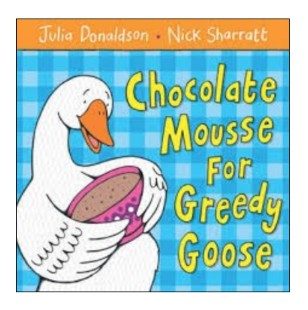 Rhyming Stories – Lots of children’s stories are written in rhyme. As you read with your child, try missing out the last word to let them fill it in.
Rhyming Stories – Lots of children’s stories are written in rhyme. As you read with your child, try missing out the last word to let them fill it in.
Here are just a few authors who write rhyming stories:
One of our favourite authors is Julia Donaldson and some of her rhyming stories have been made into animations. Why not watch some together? Zog and the Flying Doctors
Rhyme Games
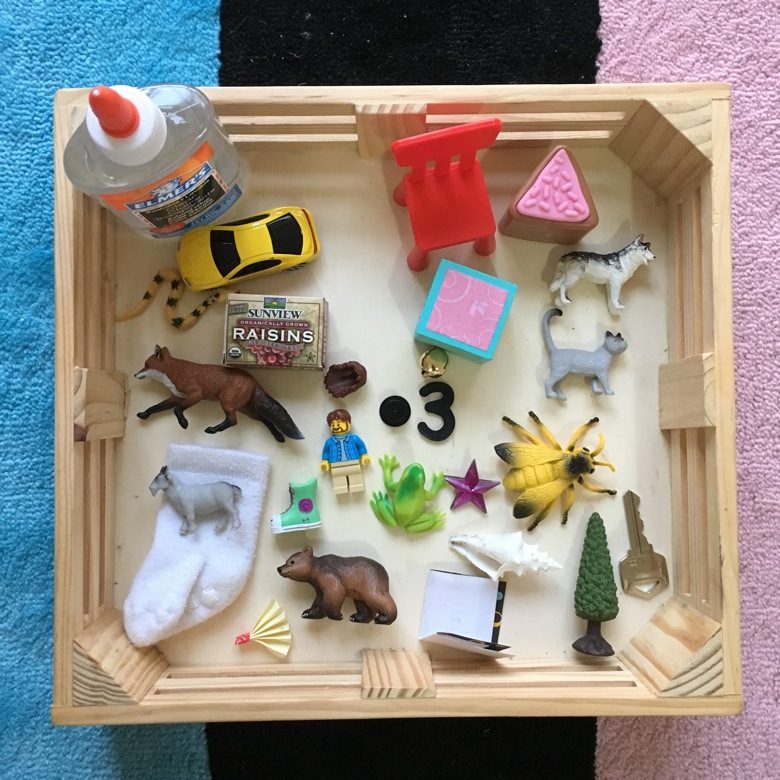 Create a rhyming basket – Collect together pairs of rhyming objects – they could be toys or household items. Take out an object… can you find it’s rhyming partner?
Create a rhyming basket – Collect together pairs of rhyming objects – they could be toys or household items. Take out an object… can you find it’s rhyming partner?
Go on a rhyming treasure hunt – Collect together some objects again but this time challenge your child to find a rhyme around your house or garden. You might put in a star (to rhyme with car), a parrot (rhymes with carrot), a bee (to match with knee or tree), a cat (rhymes with mat or hat) or a bear (to rhyme with pear). I’m sure you will think of many more!
Play I-Spy – On a walk or in the house, you could play a rhyming version of I-spy…
I spy with my little eye, something that rhymes with bee.
I spy with my little eye, something that rhymes with bog.
It’s OK if your child makes up nonsense words – that means that they have understood the concept of rhyme.
Why not play this rhyming game on the computer with Grover from Sesame Street?
Share you rhyming fun on Google Classroom or Twitter @GlenwoodFC #Glenwoodlearningathome

Children learn about numbers by hearing number sequences over and over and learning the number names. Through play and everyday activities is a natural way that children will learn.
There are lots of things you can do at home with your children to learn number sequence.
Number songs are another great way to learn number sequences. Here are some Glenwood favourites (click on them to watch a Youtube video):
Playing board and card games is another way to develop number recognition and practise counting.
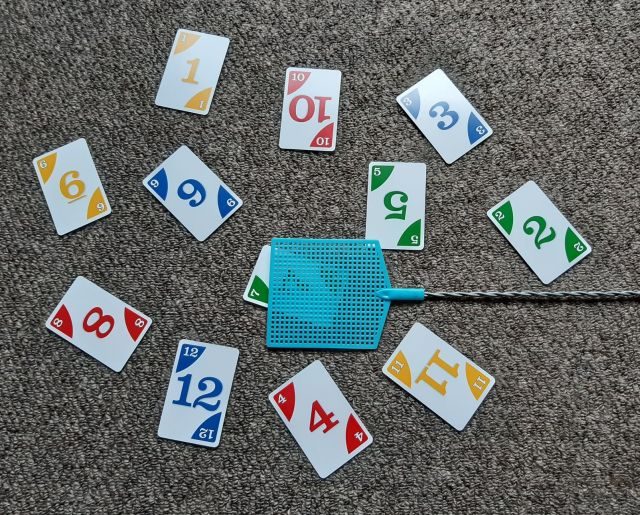
Another favourite game we play in Glenwood is Number Splat. This is a great way to develop number recognition. All you need is numbers 0-10 or 0-20 written on pieces of paper and a spatula or wooden spoon. Ask your child to splat different numbers in a random order. Why not have a competition?
Share with us on Google Classroom or Twitter how you have been practising your counting and number recognition. @GlenwoodFC #Glenwoodlearningathome
A brief History of Storytelling
 Story telling is said to have been dated right back to 30,000 BC where cavemen would draw pictures on the wall of their cave showing a short series of events usually depicting their rituals of hunting. 1,000 BC Greek myths and legends came about, and then in 700 BC the first written story was printed.
Story telling is said to have been dated right back to 30,000 BC where cavemen would draw pictures on the wall of their cave showing a short series of events usually depicting their rituals of hunting. 1,000 BC Greek myths and legends came about, and then in 700 BC the first written story was printed.
Benefits of Storytelling
Ideas to try at home…
Helicopter Stories
Helicopter Stories is a way of creating stories with your children. As a parent you’re the scribe and write word for word your child’s story down. Then have a go at acting it out…let your child decide who plays which character and what props to use.
Find out more in Miss MacLean’s Helicopter Stories Blog here.
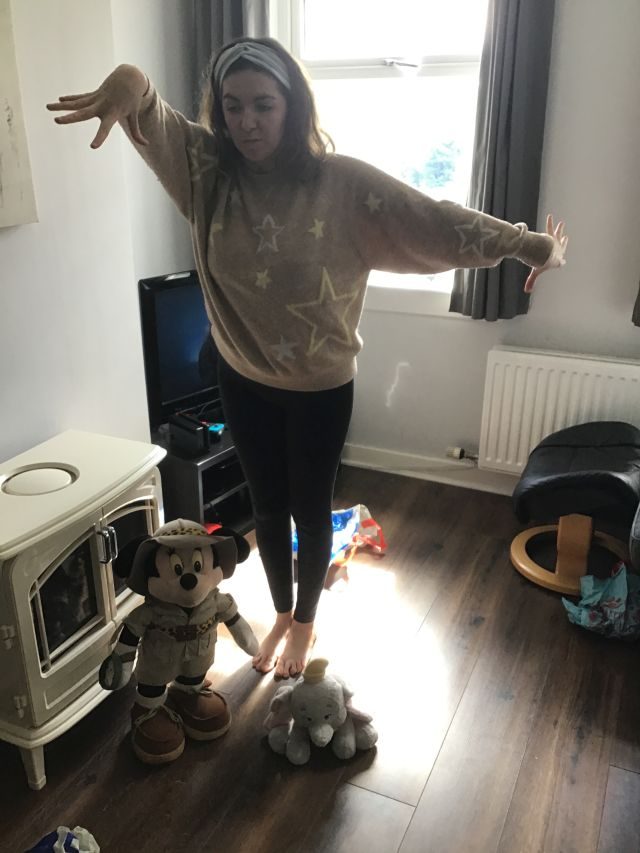
What’s in the bag?
All you need is a bag or a box filled with objects (can be anything you find around the house.) You then take turns with your child to take an object out and create a story around the object.
You could make up a station to go with the bag full of cuddly toys or dolls or toys that you could use to be the characters for your story.
This is a game that can have endless results and can be played repeatedly, as so many different stories could be told.

Hanen
In Nursery we use Hanen’s Abc and Beyond approach to develop early literacy skills. Find out more about how to turn stories into conversations in this Sway.
|
Listen to some stories together online
This ThingLink has links to many stories that you might like to share. Click on an icon to take you to the story…
We would love you to share your stories with us on Google Classroom or Twitter @GlenwoodFC #Glenwoodlearningathome
Glow Blogs uses cookies to enhance your experience on our service. By using this service or closing this message you consent to our use of those cookies. Please read our Cookie Policy.